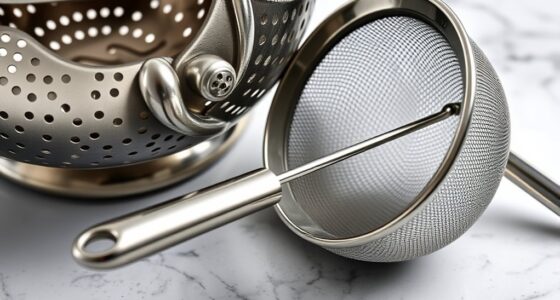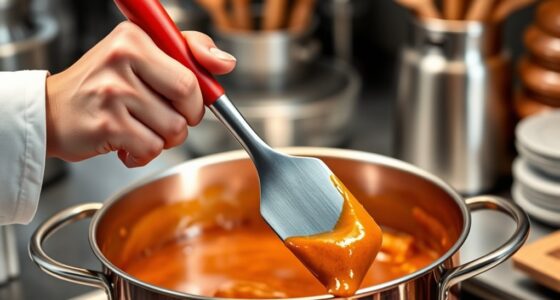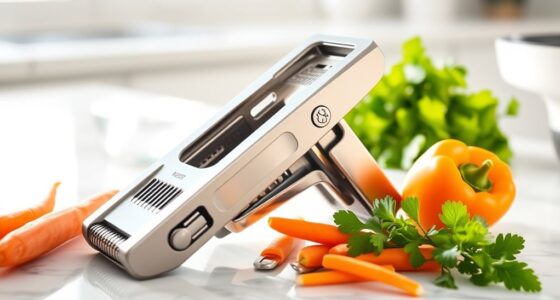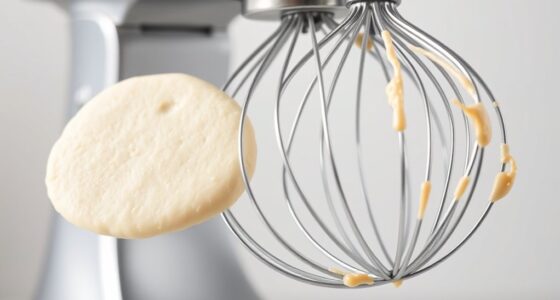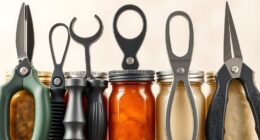The kitchen gadget that’s actually making your cooking worse is often a specialized tool designed to speed things up but ends up overcomplicating tasks, wasting time, and costing more than manual methods. For example, banana slicers and tomato cutters can crush or tear produce, while gadgets like egg crackers add unnecessary steps. Relying on skills and quality tools instead of single-use devices will make your cooking more efficient and enjoyable. Keep going to discover how to optimize your kitchen practices.
Key Takeaways
- Many gadgets add unnecessary steps, slowing down tasks instead of speeding up cooking.
- Single-use tools like banana slicers and tomato cutters often cause more mess and damage than manual methods.
- Proper skills and quality knives outperform gadgets in efficiency, precision, and versatility.
- Gadgets tend to be less effective, more expensive, and less adaptable than manual techniques.
- Overreliance on gadgets can lead to frustration, waste, and inconsistent results in the kitchen.
The Banana Slicer: A Waste of Money and Effort
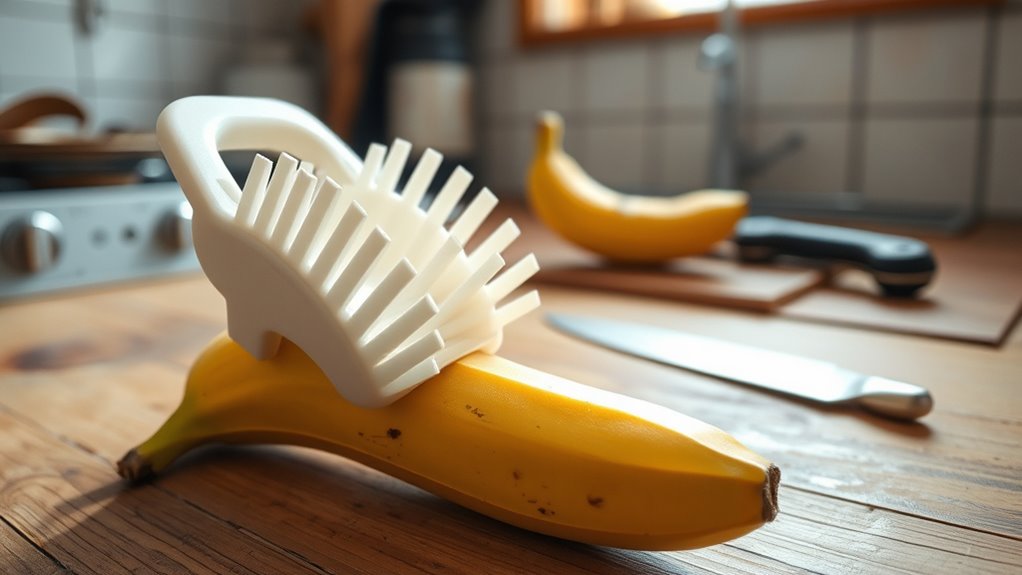
Although the idea of a banana slicer seems convenient, it often ends up being more trouble than it’s worth. Made from plastic with no sharp blades, it struggles with ripe bananas that tend to squish and break apart when you use it. Instead of quick, neat slices, you get messy, uneven pieces that end up on your cutting board. In your home kitchen, grabbing a regular knife is easier, faster, and more cost-effective than fussing with this gadget. When you need to cut bananas, the slicer just slows you down and creates more cleanup. Many find it simpler to peel and slice manually—no special tools required. Overall, a banana slicer wastes your time and money, offering no real advantage over traditional methods. Relying on necessary cookies helps improve the site’s functionality, making your experience smoother even when choosing simple tools like a knife.
Why Specialized Peeling Tools Fall Short
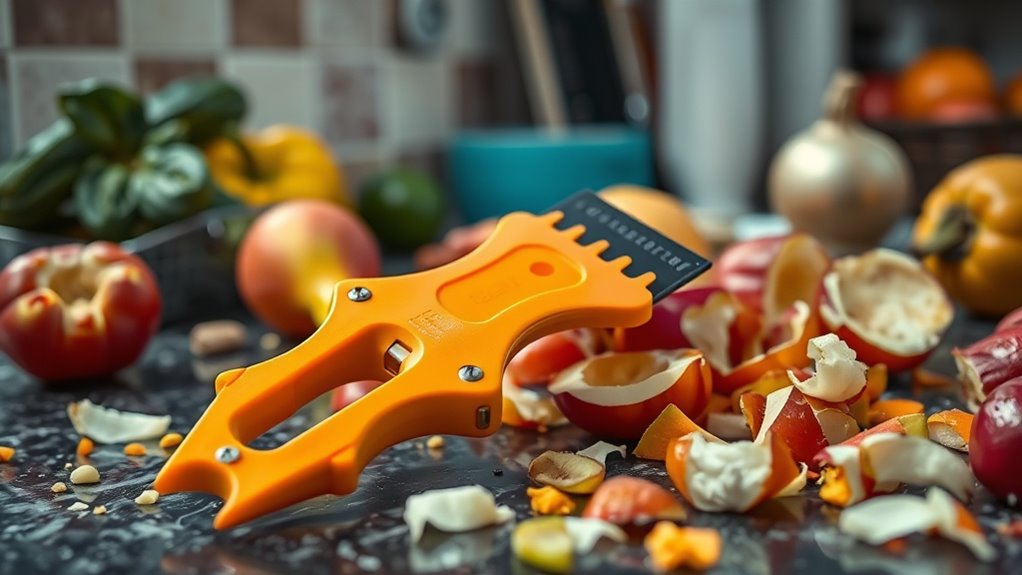
Specialized peeling tools often fall short because they lack the flexibility needed to handle various sizes and types of produce. These gadgets are typically designed for specific items, like jumbo asparagus, making them ineffective or unnecessary for everyday fruits and vegetables. When you use them on delicate or soft produce, they can cause damage or remove uneven patches of skin. Proper peeling usually requires a steady hand and a paring knife, which gives you better control and adaptability. Relying on these single-purpose tools can be frustrating and often results in wasted produce or uneven peeling. Investing in a quality peeler or a sharp knife offers more versatility and consistent results, saving you time and effort while improving your cooking. Additionally, understanding essential oil safety and proper storage can enhance your overall kitchen experience by preventing mishaps and preserving your tools. Using ergonomic designs in peelers can also reduce hand fatigue and improve precision during peeling tasks. Incorporating spiritual energy awareness into your kitchen routine can help foster a mindful cooking environment that promotes patience and focus during food prep. Being mindful of air purifier maintenance can also contribute to a cleaner and more pleasant kitchen atmosphere, ultimately supporting your cooking efficiency.
Tomato Slicers: Ripping and Wasting Your Produce

Tomato slicers often have dull blades that crush instead of cut cleanly, causing damage and waste. Ripping the fruit with these gadgets wastes produce and takes longer than using a sharp knife. Manual slicing with a good knife usually gives better, neater results without the hassle.
Dull Blades Damage Tomatoes
Dull blades on tomato slicers often cause more harm than good by crushing and tearing the fruit instead of making clean cuts. When your blades are dull, you need to apply more force, which increases the risk of damaging the tomato’s delicate structure. Instead of neat slices, you end up with squashed or torn produce, wasting valuable ingredients and ruining presentation. Dull blades don’t just make slicing harder—they compromise quality. Regularly sharpening or replacing blades can restore clean, smooth cuts and reduce unnecessary damage. Using a sharp slicer ensures your tomatoes stay intact, look appealing, and waste is minimized. Cheating in the kitchen can sometimes involve shortcuts that compromise quality, like neglecting proper maintenance of your tools. Don’t settle for dull blades that damage your produce—invest in maintaining your slicer to improve your results and save money in the long run.
Ripping Over Slicing Technique
If you rely on a basic tomato slicer with dull blades, you’re more likely to rip and tear your produce instead of slicing it neatly. This poor slicing technique damages the tomato’s flesh, leading to uneven, messy slices and unnecessary waste. Instead of a clean cut, you might find yourself applying excessive pressure, causing the tomato to crush or tear. Incorporating advanced automation technology in kitchen appliances can help ensure precise cuts and reduce waste. To improve your slicing technique:
- Use a sharp knife for cleaner, more precise cuts
- Apply gentle, even pressure without forcing the slice
- Keep the tomato steady for consistent, neat slices
Proper knife skills can make a significant difference in the quality of your slices and help prevent waste. Ripping over slicing your tomatoes not only destroys their appearance but also reduces usability. A proper slicing technique with a sharp knife ensures less produce waste and better presentation, making your cooking more efficient and enjoyable. Additionally, understanding sound science in kitchen tools can guide you toward selecting appliances that minimize damage during food preparation. Recognizing the importance of tuning and maintenance of your kitchen gadgets can also extend their lifespan and performance, ensuring cleaner cuts every time. Developing a good kitchen safety habit when handling sharp tools can further enhance your cooking experience and prevent accidents.
Better Manual Alternatives
Relying on basic tomato slicers with dull blades often leads to crushing and ripping your produce instead of creating neat, uniform slices. To improve your results, use a sharp knife and a steady hand in your home kitchen. A serrated knife is ideal for tomatoes because it cuts through the skin easily without damaging the delicate interior. With a little practice, you can slice tomatoes quickly and evenly, reducing waste and spoilage. Manual slicing is faster, more affordable, and produces better presentation compared to most commercial tomato slicers. Plus, it minimizes produce destruction and ensures your dishes look professional. Ditch the ineffective gadgets and embrace simple, precise manual techniques for superior results. Additionally, focusing on proper knife skills can further enhance your slicing accuracy and efficiency. Developing manual dexterity can also boost your confidence and control during slicing tasks, leading to even better outcomes. Incorporating basic culinary techniques can help you refine your overall kitchen skills and achieve more consistent results. Improving your slicing technique can lead to less produce waste and a more enjoyable cooking experience, especially when combined with an understanding of food safety practices to keep your ingredients fresh.
The Illusion of Convenience: Egg Crackers and Pickle Pickers

Many kitchen gadgets promise to make tasks quicker and easier, but egg crackers and pickle pickers often do the opposite. These tools create a false sense of convenience, making simple tasks more complicated. Egg crackers tend to crack eggs unevenly, increasing yolk breakage and forcing multiple attempts. Pickle pickers, usually small plastic tools, offer limited practicality and are hard to handle with different pickle sizes. Additionally, water-based activities like aquatic exercise demonstrate that traditional methods often outperform gadgets in efficiency and effectiveness. Consider these points: – They cost more than they’re worth. – Manual methods are more controlled and efficient. – These gadgets often add unnecessary steps to simple tasks. Furthermore, studies show that relying on proper technique yields better results than using specialized tools. When it comes to everyday kitchen tasks, developing manual skills can save time and reduce frustration.
When Gadgets Complicate Simple Tasks
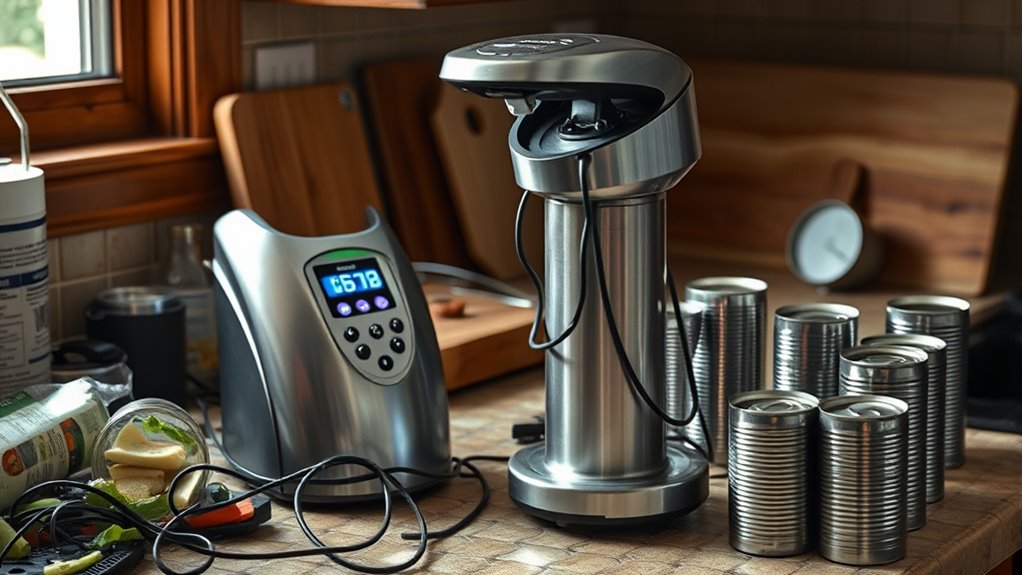
Gadgets that promise to simplify cooking often end up making tasks more complicated by adding extra steps and confusing procedures. Instead of saving time, these gadgets can slow you down, forcing you to learn new techniques or clean up messes. For example, specialized tools like banana slicers or tomato cutters might seem helpful but often turn out to be less effective than just using a good knife. Similarly, gadgets like herb shears or vegetable choppers can limit versatility, requiring multiple steps for simple tasks. This overcomplication can lead to frustration and inconsistency in your cooking. Ultimately, these gadgets can do more harm than good, making you spend more effort troubleshooting than actually preparing your food efficiently.
Investing in Skills and Quality Tools Over Single-Use Devices
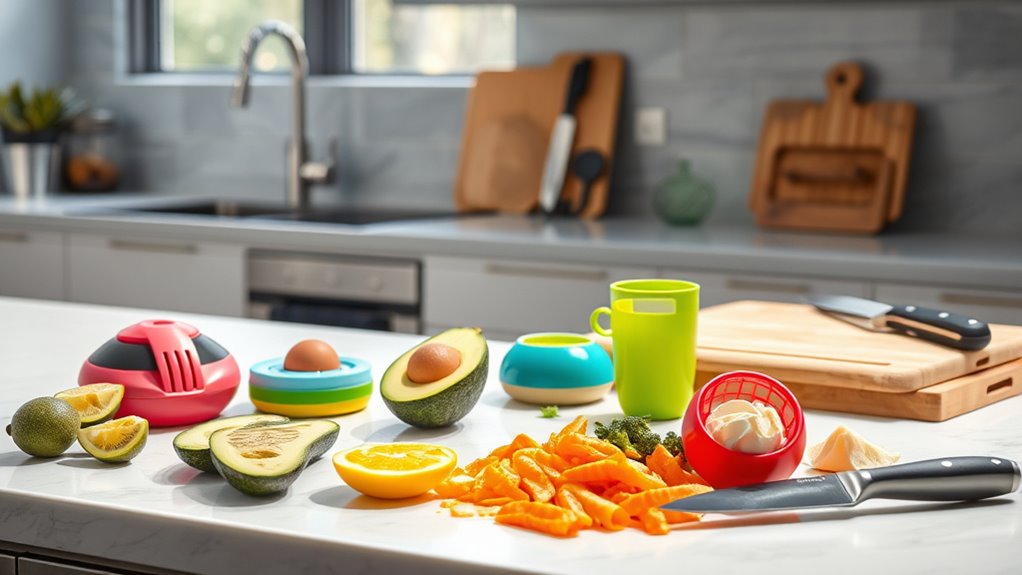
Instead of filling your kitchen with single-use gadgets, investing in a high-quality, versatile knife and honing your skills can make a significant difference. Quality tools like a sharp, durable knife allow you to cut more efficiently and precisely, reducing your reliance on limited, costly gadgets. Developing proper knife skills means you can handle most tasks with fewer tools, saving money and space. Basic tools combined with practice outperform specialized devices like egg crackers or herb shears. To make your kitchen more efficient, focus on:
Invest in a quality knife and hone your skills for a more efficient, clutter-free kitchen.
- Purchasing versatile, high-quality tools that last
- Improving your skills to maximize tool effectiveness
- Avoiding clutter caused by unnecessary, single-purpose gadgets
Prioritizing skill development and quality tools ensures better results, a more organized space, and a more cost-effective cooking experience.
Frequently Asked Questions
What Is the Most Essential Tool in the Kitchen?
The most essential tool in your kitchen is a high-quality chef’s knife. It’s versatile enough to handle slicing, dicing, and chopping, making your prep faster and more precise. Instead of cluttering your space with gadgets that underperform, focus on investing in a reliable, well-made knife. With good technique, you’ll find it can replace multiple tools and markedly elevate your cooking experience.
What Are the 10 Kitchen Tools and Their Uses in Order?
Imagine a chef from the Renaissance era asking about modern kitchen tools. You need a good chef’s knife for chopping, then a cutting board for stability. Follow with a peeler for vegetables, a whisk for mixing, and a spatula for flipping. Add measuring cups for accuracy, a saucepan for boiling, a colander for draining, and a timer for precision. These tools streamline your workflow and elevate your cooking game.
What Is the Most Versatile Cooking Tool?
You probably wonder what the most versatile cooking tool is. It’s your chef’s knife. With a sharp, high-quality knife, you can chop, slice, dice, and mince effortlessly. It’s an all-in-one tool that handles various tasks, reducing clutter and saving money. Using it with proper technique improves your efficiency and safety. Investing in a good chef’s knife makes your cooking smoother, more precise, and more enjoyable.
What Is the Useful Tool in the Kitchen?
When you ask about a useful kitchen tool, focus on a versatile item like a sharp, quality knife. It handles multiple tasks, from chopping vegetables to slicing meats, saving you time and effort. Avoid single-purpose gadgets that often complicate or slow down your cooking. Instead, invest in good basics and ergonomic tools to improve safety, comfort, and results in your kitchen every day.
Conclusion
Instead of cluttering your kitchen with gadgets that promise ease but deliver frustration, focus on honing your skills and choosing quality tools. Imagine a cluttered drawer filled with single-use devices versus a well-organized space with versatile, reliable utensils. The difference is clear: one offers simplicity and confidence, while the other creates chaos and wasted effort. Prioritize what truly helps you cook better—your skills and good tools—over gimmicks that make everything more complicated.


